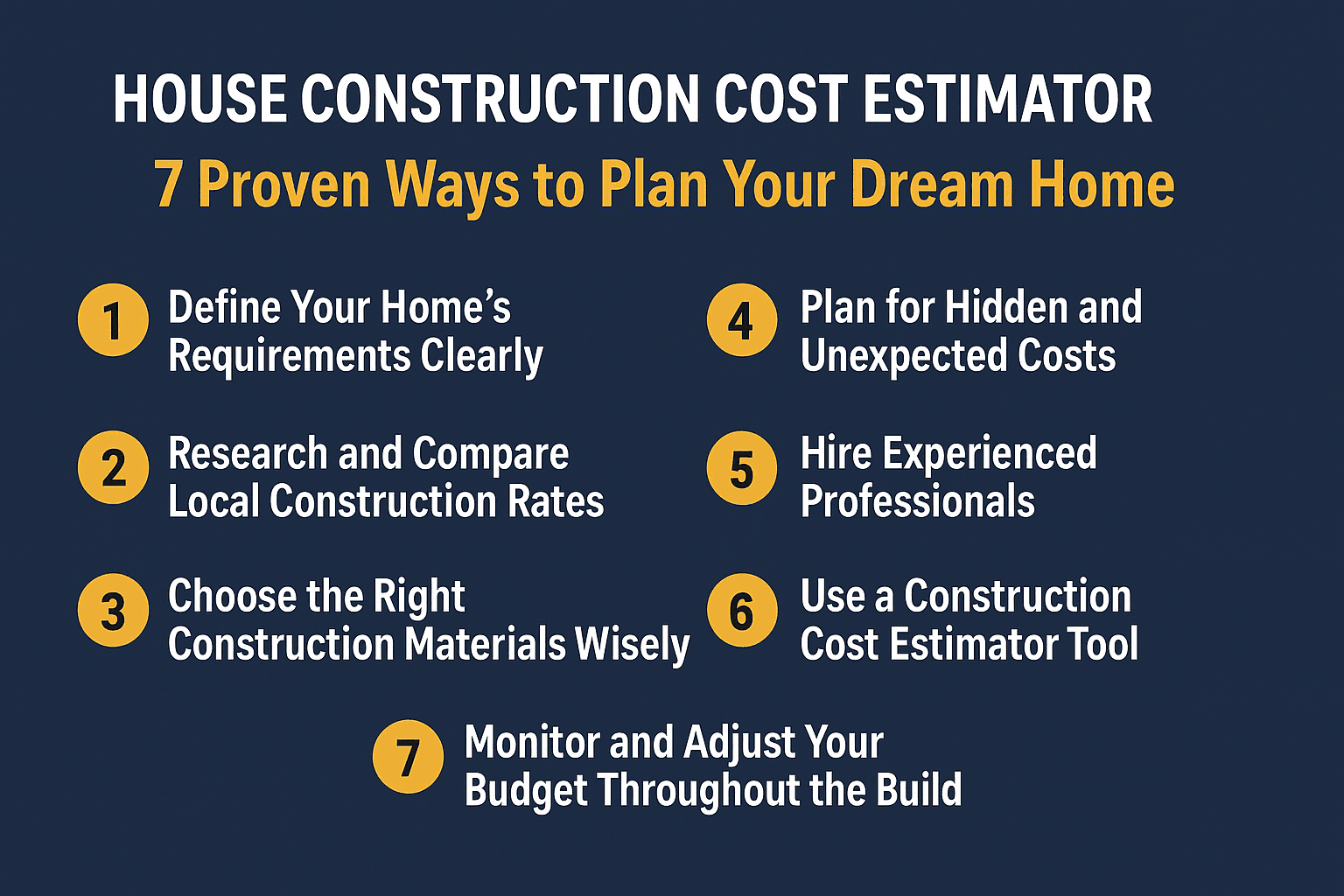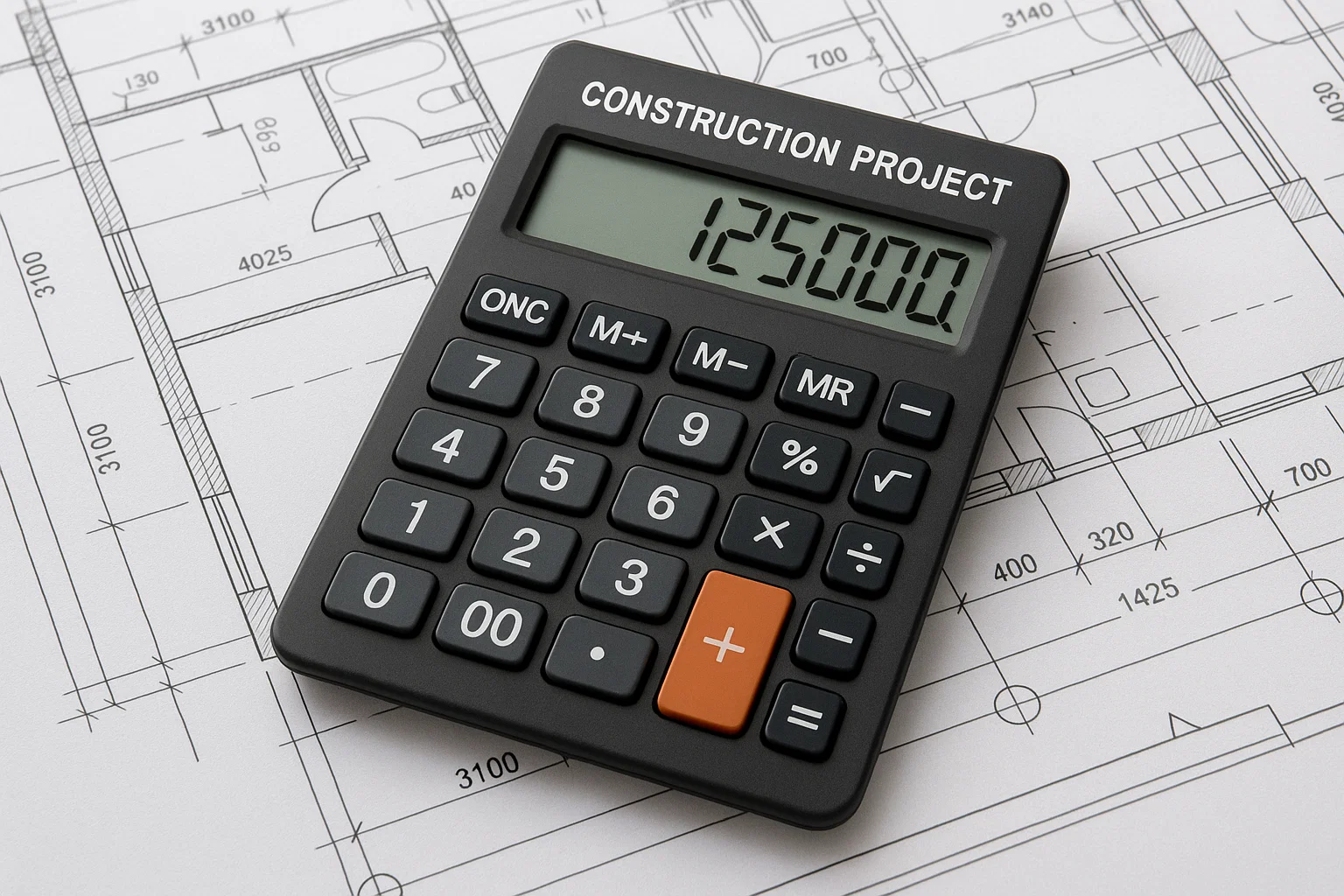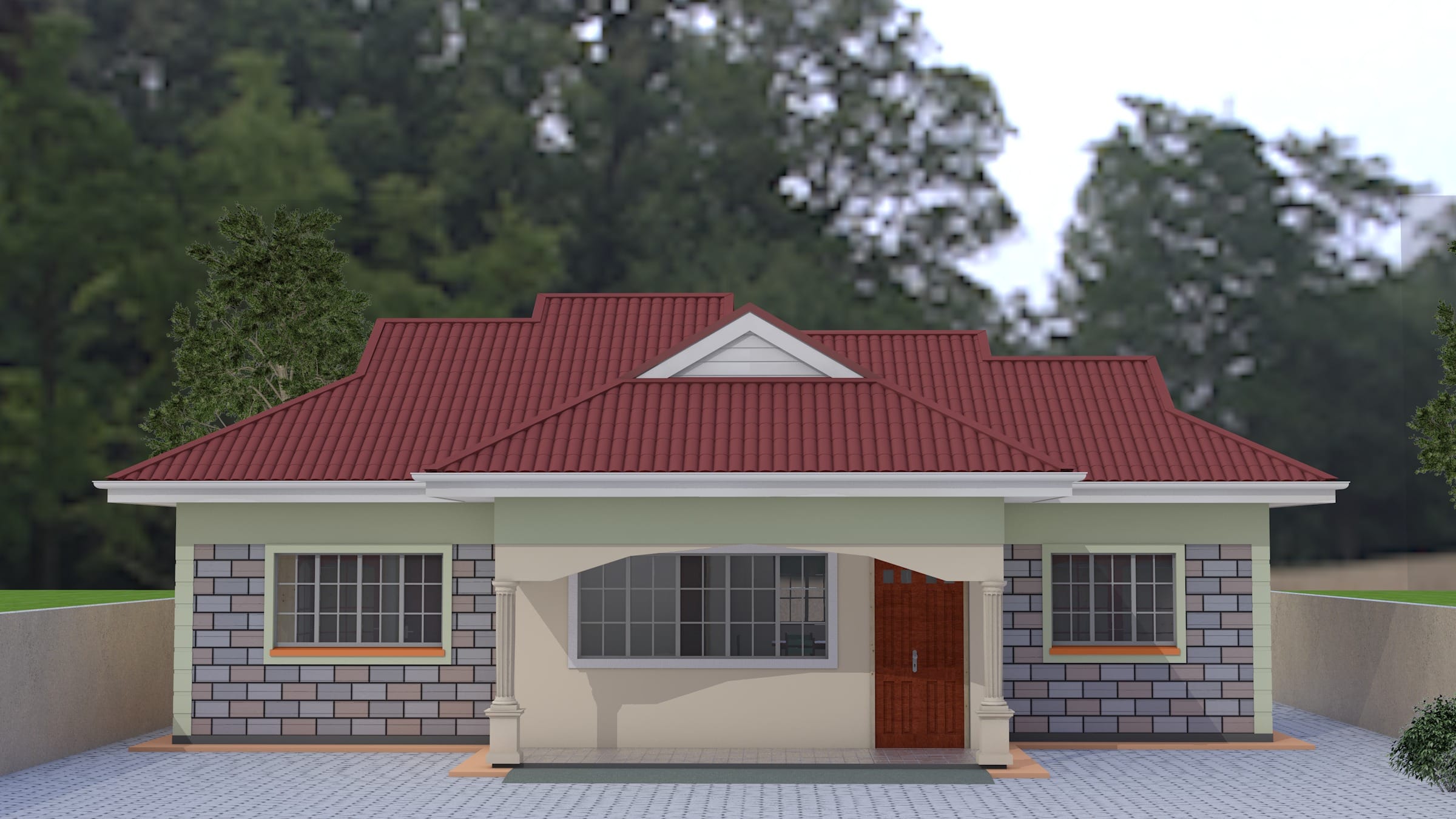Construction, House Plans
House Construction Cost Estimator: 7 Proven Ways to Plan Your Dream Home
Introduction to House Construction Costs
A house construction cost estimator is your best friend when you are planning to build your dream home because it helps you create a clear financial roadmap before the first brick is laid. Building a house is one of the most exciting projects you will ever take on, but it can also be one of the most expensive and stressful if you do not plan properly. Every decision you make from choosing the land to selecting materials and hiring professionals has a direct impact on your final costs. Without proper budgeting, expenses can quickly spiral and turn your dream project into a financial headache.
Cost estimation is not just about predicting how much you will spend. It is about knowing where your money will go and how to allocate it wisely so that you can prioritize essential elements such as structural strength, energy efficiency, and long-term durability while avoiding unnecessary spending on features that can wait. A well-prepared cost plan also gives you an advantage when securing financing since lenders prefer detailed, realistic budgets. It allows you to negotiate better with contractors and suppliers because you will know the fair market rates for labor and materials.
In this article, you will discover seven proven ways to plan your dream home without breaking the bank, starting with understanding the fundamentals of cost estimation and avoiding common budgeting mistakes, then moving into practical strategies for saving money, choosing materials, managing hidden costs, hiring the right professionals, using digital estimator tools, and monitoring your budget all the way to completion. This guide will ensure that your homebuilding journey stays exciting, rewarding, and financially manageable from blueprint to final key in hand.
Why Cost Estimation Matters Before Building
Imagine starting a cross country road trip without setting aside a fuel budget. It would almost certainly lead to frustration and failure. The same principle applies to building a home. Without a cost estimation, you risk running out of funds before the project is complete. This can force you to compromise on essential features, take on expensive loans, or even stop construction altogether.
Cost estimation is about much more than simply knowing the total amount you will spend. It is about understanding exactly where each portion of your budget will be used. This allows you to focus your spending on critical aspects such as structural safety, energy efficiency, and long term durability rather than exhausting funds on cosmetic extras too early in the process.
A detailed and realistic cost estimate can also improve your chances of securing financing. Banks and lenders are more likely to approve loans when they see a well researched budget that covers every stage of the build. Having this information also helps you negotiate more effectively with contractors since you will already know what fair pricing for labor and materials should look like.
In short, accurate cost estimation safeguards your finances, protects your vision, and gives you the confidence to move forward without second guessing every decision.
The Common Mistakes Homeowners Make in Cost Planning
Many homeowners unknowingly sabotage their construction projects before they even start. Here are the most common cost planning mistakes:
Underestimating Land Costs: People often focus solely on building costs without factoring in the price of land preparation, grading, and site access.
Ignoring Inflation: Material and labor costs fluctuate over time; failing to account for this can lead to budget gaps.
Over-Optimistic Timelines: Delays mean extended labor costs and sometimes increased material prices.
Choosing Luxury Over Necessity: Overspending on high-end finishes early can leave no room for essentials later.
Neglecting Legal and Permit Fees: These can run into thousands, depending on local regulations.
By avoiding these pitfalls, you can prevent financial strain and keep your project on track.
Understanding the Basics of House Construction Cost Estimation
Before diving into the specific cost-saving strategies, you need to grasp the basic framework of how construction costs are calculated. Construction budgeting isn’t a random guess; it’s a detailed breakdown of various cost components.
Key Components of a Construction Budget
A well-structured construction budget typically includes:
Land Costs: Purchase price, legal fees, land surveys, and preparation work.
Design and Planning Costs: Architect fees, engineering consultations, and blueprint development.
Material Costs: Cement, steel, wood, roofing, finishes, and fixtures.
Labor Costs: Wages for contractors, builders, electricians, and plumbers.
Permits and Inspection Fees: Local government fees to approve your build.
Utility Installation: Water, electricity, and sewage connections.
Contingency Funds: Extra money set aside for emergencies or unexpected price hikes.
Understanding these components ensures your estimation is thorough and realistic.
Factors That Influence House Construction Costs
Several variables affect how much your home will cost to build:
Location: Urban areas often have higher labor rates and permit fees compared to rural zones.
Size of the House: Larger homes require more materials and labor hours.
Design Complexity: Intricate designs cost more to execute than simple, rectangular layouts.
Material Quality: Premium materials boost both quality and cost.
Labor Availability: In areas where skilled workers are scarce, wages tend to be higher.
Economic Conditions: Inflation, supply chain disruptions, and market demand all impact prices.
By understanding these influences, you can adjust your plan to keep costs in check.

Proven Way 1: Define Your Home’s Requirements Clearly
The first and most important step in keeping your construction budget under control is knowing exactly what you want and committing to it. A vague or constantly changing vision is one of the fastest ways to overspend. When you are clear about your needs from the start, you give your contractor the ability to provide an accurate estimate and you reduce the risk of costly changes once the project is underway.
Determining Size, Style, and Features
Before you speak to a builder, take the time to decide on the specifics of your home. Ask yourself how many rooms you need, what style of architecture you prefer such as modern, traditional, or minimalist, and which features are essential compared to those that are simply nice to have. Being precise with these decisions helps your team plan more effectively and prevents confusion that can lead to budget overruns.
The Importance of a Realistic Vision
While it is natural to dream big, your vision should also be grounded in practicality. It can be tempting to include luxuries such as a rooftop pool or imported marble countertops, but these additions can quickly consume a large part of your budget. Instead, focus on features that will truly enhance your lifestyle and add long term value to your property. By balancing your desires with your budget, you create a plan that delivers both satisfaction and financial stability.
Proven Way 2: Research and Compare Local Construction Rates
Prices vary dramatically depending on where you build.
Understanding Regional Price Variations
Urban construction often costs more due to higher labor wages, stricter building codes, and premium land values. Conversely, rural areas may have cheaper land but higher transportation costs for materials.
How to Negotiate with Contractors
Always get at least three quotes from reputable builders. Use your research to negotiate better rates. Be clear about your budget from the start and ask for a breakdown of costs so you know where every dollar is going.
Proven Way 3: Choose the Right Construction Materials Wisely
Selecting materials is one of the most important budget decisions you’ll make when building your dream home. Materials impact not only the aesthetics of your house but also its longevity, maintenance needs, and overall cost. While it’s tempting to splurge on high-end options, strategic choices can save you thousands without compromising quality.
Balancing Quality and Cost
The key to material selection is finding a sweet spot between affordability and durability. Going for the cheapest materials might seem like a smart move at first, but they often lead to higher maintenance costs in the future. On the flip side, top-tier luxury materials can drain your budget unnecessarily.
For example:
Instead of solid hardwood flooring, you could opt for engineered wood or high-quality laminate that mimics the look at a fraction of the price.
For countertops, quartz or composite stone offers similar beauty to marble but at a much lower cost and with better resistance to stains.
Energy-efficient windows may cost more upfront but can significantly reduce your utility bills over the years.
By considering long-term benefits rather than just initial expenses, you can invest wisely.
Cost-Saving Tips Without Sacrificing Durability
Buy in Bulk: Purchasing large quantities often unlocks wholesale discounts.
Use Locally Sourced Materials: This reduces transportation costs and supports your local economy.
Mix and Match: Combine premium finishes in key areas with budget-friendly materials elsewhere.
Consider Alternatives: Instead of traditional brick, lightweight concrete blocks or modular panels can be faster and cheaper to install.
Reclaimed Materials: Salvaged wood, doors, and fixtures can add character to your home while saving money.
Remember, your material choices will directly affect the long-term comfort and resale value of your home. Spend wisely and avoid being swayed solely by trends; they often fade, but the bills remain.
Proven Way 4: Plan for Hidden and Unexpected Costs
Even the most detailed construction budgets can be derailed by expenses you didn’t see coming. These hidden costs are the silent budget killers, and failing to account for them can cause major financial stress during your build.
Common Hidden Costs in Construction
Permit Fees: Beyond standard building permits, you might need special permissions for electrical, plumbing, or zoning variances.
Soil Testing and Site Preparation: Poor soil conditions can require costly foundation reinforcements.
Utility Hookups: Water, sewage, electricity, and internet connections often involve separate fees.
Change Orders: Altering designs mid-build is one of the costliest mistakes.
Weather Delays: Extra labor costs may arise when timelines are extended.
Waste Disposal: Hauling away construction debris isn’t always included in contractor quotes.
Building a Safety Margin in Your Budget
A golden rule in construction is to set aside at least 10–15% of your total budget for unexpected expenses. Think of it as an insurance policy for your project.
This extra buffer ensures that if a surprise cost arises; like discovering termite damage during demolition or having to upgrade wiring to meet code, you won’t need to pause the build or take on high-interest loans.
A realistic budget isn’t about avoiding surprises entirely (because you can’t), but about being financially ready when they appear.
Proven Way 5: Hire Experienced Professionals
Hiring the right people can make or break your project. Experienced professionals don’t just deliver quality work; they also help you stay within budget by avoiding costly mistakes, delays, and rework.
Why Expertise Matters in Cost Control
A skilled architect can design a home that maximizes space and energy efficiency while minimizing unnecessary building complexity. Likewise, seasoned contractors often have established supplier relationships that secure better pricing on materials.
Inexperienced builders, on the other hand, may underestimate timelines, mishandle resources, or make errors that require expensive corrections.
Tips for Selecting Architects, Engineers, and Builders
Check Credentials: Verify licenses, certifications, and insurance coverage.
Review Past Work: Ask to see portfolios and visit completed projects in person if possible.
Read Reviews and References: Feedback from past clients reveals reliability and professionalism.
Get Detailed Contracts: Ensure agreements clearly outline scope, timeline, payment terms, and penalties for delays.
Prioritize Communication: Choose professionals who are transparent, responsive, and willing to explain costs clearly.
Hiring the best talent may cost a little more upfront, but it often saves you far more in avoided mistakes and increased efficiency.
Proven Way 6: Use a Construction Cost Estimator Tool
Technology has revolutionized the way homeowners plan their dream homes, and one of the most valuable advancements is the construction cost estimator tool. These tools provide a detailed projection of your total building costs based on inputs like location, size, materials, and labor rates.

Benefits of Digital Cost Estimation
Accuracy in Budgeting: By analyzing current market prices for materials and labor, these tools provide a more precise estimate than guesswork.
Time Savings: Instead of calling multiple suppliers and contractors, you can get a quick overview in minutes.
Scenario Testing: You can easily adjust specifications (like changing roofing material or adding a garage) to see how they impact the total cost.
Better Negotiation Power: Armed with accurate numbers, you can challenge overpriced contractor quotes.
Transparency: You see exactly how costs are distributed, reducing the risk of hidden charges.
Some of the most reliable estimators also factor in inflation trends, regional labor variations, and seasonal material price changes. This allows you to time your purchases and labor hiring for maximum savings.
How to Read and Understand an Estimation Report
An estimator tool usually breaks down costs into categories like:
Foundation: Excavation, footings, concrete work.
Structure: Framing, beams, roofing.
Interior Finishes: Flooring, painting, cabinetry.
Mechanical Systems: Electrical, plumbing, HVAC.
Exterior Work: Landscaping, driveways, fencing.
When reviewing your report, pay attention to:
Per square foot costs: Useful for comparing with other builds in your area.
Labor-to-material cost ratio: Helps identify where your money is going.
Contingency allowance: Ensures you’ve factored in unexpected costs.
A cost estimator tool doesn’t replace professional advice, but it does give you a strong foundation for budget planning.
Proven Way 7: Monitor and Adjust Your Budget Throughout the Build
Even with the best planning, costs can shift during construction. This is why ongoing budget monitoring is critical. Think of it as your financial “GPS” guiding you to the finish line without detours.
Tracking Expenses in Real-Time
A spreadsheet is good, but project management apps are even better. Platforms like Buildertrend, CoConstruct, or even Trello allow you to track expenses daily, compare them against your original budget, and flag overspending before it spirals.
Some practical tips:
Keep all receipts and invoices: They’re essential for tracking and dispute resolution.
Update your budget weekly: Waiting until the end of the month can hide overspending trends.
Categorize every expense: This makes it easier to identify problem areas (like materials or labor).
How to Avoid Cost Overruns During Construction
Stick to the Original Plan: Constant design changes are a budget killer.
Approve Purchases in Advance: Ensure major buys are pre-approved and within the set budget.
Schedule Wisely: Delays can increase labor and equipment rental costs.
Negotiate Regularly: Keep communication open with contractors about cost-saving opportunities.
Be Present on Site: Sometimes, just showing up ensures that the work is done efficiently and materials aren’t wasted.
By keeping a close eye on your spending and making small adjustments along the way, you can finish your dream home without unpleasant financial surprises.
Conclusion: Turning Your Dream Home into Reality Without Breaking the Bank
Building your dream home is a milestone that should bring joy, pride, and comfort for years to come. With the right planning, it does not have to drain your finances or cause unnecessary stress. By defining your requirements clearly, researching costs, selecting materials wisely, preparing for hidden expenses, hiring skilled professionals, using reliable construction cost estimator tools, and monitoring your budget from start to finish, you can complete your home on time and within budget.
The key is not to cut corners but to make informed decisions at every stage of the process. When you approach your build with a clear plan, realistic expectations, and professional guidance, you turn your dream home from a distant goal into a beautiful reality.
If you want a trusted partner to help you plan and manage your project effectively, Nyolenju Structures is here to guide you every step of the way. From accurate cost estimation to professional construction management, our team ensures that your home is built to last and delivered within budget.
Start your journey today by contacting Nyolenju Structures for a free consultation and let us help you bring your dream home to life without breaking the bank.
FAQs
1. How accurate are online house construction cost estimators?
They’re generally accurate within a 10–15% range, but local market conditions can cause variations. Always cross-check with professional quotes.
2. What’s the biggest mistake people make when estimating costs?
Underestimating hidden expenses and making frequent design changes mid-project.
3. Can I reduce costs without compromising on quality?
Yes. Choose durable but cost-effective materials, hire experienced professionals, and negotiate bulk purchase discounts.
4. How much extra should I budget for unexpected expenses?
Set aside at least 10–15% of your total budget as a contingency fund.
5. Should I hire a project manager for my home construction?
If you lack experience in construction, hiring a project manager can save you time, reduce stress, and help control costs.


